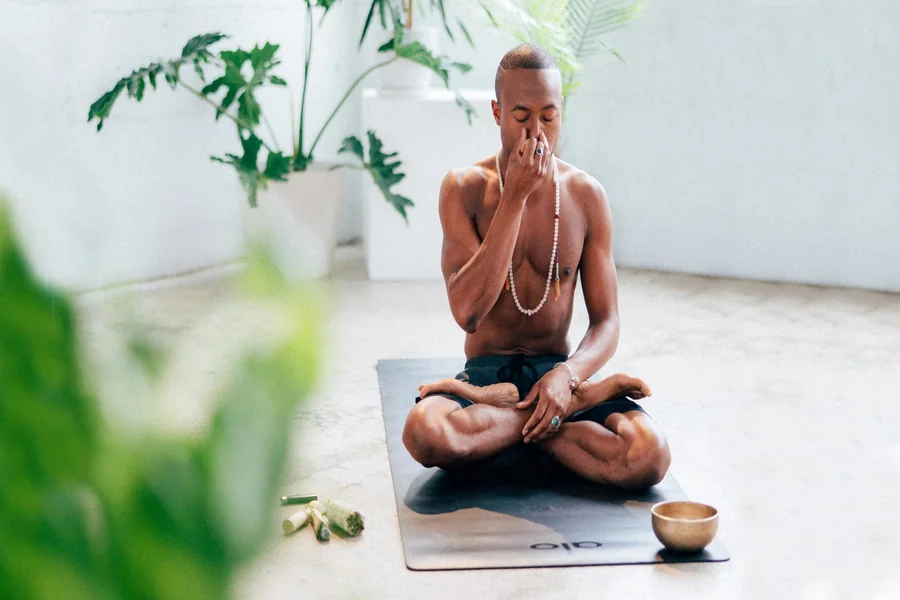Modern days start with vibration and light. A phone lights the room before the sun. Notifications arrive faster than breaths. Attention splits across tabs, chats, and tasks. Shoulders lift toward ears, jaws clench, and breathing becomes shallow. This baseline—mild tension plus constant distraction—shapes how you feel, what you choose, and how you treat people. When attention fragments, small irritations feel larger, decisions drift toward habit, and evenings blur without recovery.
Mindfulness offers a counter-pattern. At its simplest, it is trained, non-judgmental attention to the present moment. You are not trying to engineer a perfect mind or erase thoughts. You are practicing three moves: noticing what is here, allowing it to be here, and choosing the next wise step. This skill can be trained in short sessions and applied inside real life—emails, commutes, parenting, workouts, and hard conversations. The payoff touches mood, focus, health behaviors, and relationships.
You do not need a mountain cabin or hours of free time. You need a repeatable way to return attention, a kinder inner tone, and small cues placed in your day. In the pages ahead you will build a practical skill stack, wire it into morning and evening routines, use it during work and conflict, and navigate common roadblocks without quitting. A 14-day plan anchors progress and provides simple metrics. You finish with a culture that supports practice—a chair, a light, a friend who texts “I sat,” and a forgiving approach to starting again.
The Skill Stack: What You Actually Train
Attention is the first pillar. Attention means selecting an object—breath, sound, body sensation, or a visual point—and staying with it for a few moments. Wandering is expected. Returning is the rep that builds the muscle. Start with a 30-second breath check. Sit or stand, feel the next inhale and exhale, and notice where you feel it most—nostrils, chest, or belly. The moment you realize the mind has left, name it “thinking,” and come back. Add the “name three sounds” game: pause, name three distinct sounds, and then one quiet sensation inside the body. These micro-drills create a thread of steadiness you can pick up anywhere.
Awareness widens the frame. If attention is a flashlight, awareness is the room light. You make space for sensations, thoughts, and moods without fusing to them. A three-minute body scan helps build this stance. Start at the forehead and move down to the toes, gathering sensations—warmth, pressure, tingling—without commentary. Where you find tension, try a “tension–soften cycle”: gently tighten the area on an inhale, then release on the exhale and feel the contrast. This trains the ability to detect early signals—tightness before irritability, speed before carelessness.
Attitude makes the practice humane. Technique without kindness becomes another arena for self-critique. Curiosity replaces judgment. When you catch yourself evaluating your practice—“This is pointless” or “I’m bad at this”—ask a gentler question: “What is this like right now?” Shifting from “Why am I like this?” to “What is this like?” turns analysis into observation, which is workable. You can relate to the moment you have, not the moment you wish you had.
Acceptance and action work together. Mindfulness asks you to allow what is present and then choose a response. Allowing is not passivity. It is pausing long enough to see what is real. Use the two-step: acknowledge → pick a next wise move. First say, “Anxiety is here,” or “Anger is here.” Then choose one small action aligned with values: send the email you’ve delayed, take a short walk to reset, rewrite the message in calmer language, or make a call you’ve avoided. This pairing makes mindfulness practical in pressure moments.
Measurement keeps you honest. You do not need a complex dashboard. Track minutes practiced, number of returns during a session, perceived stress on a 1–10 scale, sleep quality on a 1–5 scale, and one anecdote each week where you saw a different choice appear. These metrics are simple enough to maintain and concrete enough to show change.
Daily Life, Rewired: Where Mindfulness Changes the Day
Mornings set the baseline. A five-minute sit before screens stabilizes attention and slows the nervous system. Sit upright, let the shoulders drop, place hands on thighs, and follow the breath for 20 cycles. If five minutes feels long, do two minutes and add one minute each week. Choose one mindful task to anchor the morning: shower, coffee, or dressing. For the shower, feel water temperature on shoulders and back; notice the urge to race, and deliberately slow one breath. For coffee, grind the beans with full attention, smell the grounds, pour water, and watch the bloom. End with an intention sentence: “Today I will bring patience to interruptions,” or “Today I will close each task before opening a new tab.”
Work and focus improve with structure. Multitasking is a myth at the cognitive level; the brain switches tasks at a cost. Use 25/5 sprints—25 minutes of single-task work followed by a five-minute break. At the top of each sprint, do a 60-second “arrive before you write” breath, then type the first sentence without checking messages. Adopt a “one-tab rule” for deep work blocks. Keep only the relevant tab open; copy links to a temporary note if you fear losing them. Before meetings, ask the team for a 30-second check-in: each person names one word for their current state and one sentence for the meeting’s purpose. Before decisions, hold a 10-second pause to feel the body and the breath; then speak. These tiny rituals reduce reactivity and cut mistakes.
Stress and emotion can be surfed. RAIN is a reliable shorthand: Recognize what is present, Allow it to be here, Investigate with gentle curiosity, and Nurture with a supportive response. Example: “Tight chest—anxiety. It’s here. What is this like in the chest? Heat and pressure. Hand on heart. It’s hard, but I’m here.” For cravings or urges, use urge surfing: watch the urge rise, peak, and fall like a wave, noticing bodily sensations and thoughts without acting for one minute. For acute spikes, practice 4-7-8 breathing: inhale for 4, hold for 7, exhale for 8, repeat four cycles. This lengthens exhalations, which shifts the nervous system toward calm. These tools apply whether you are frustrated in traffic, rushing a deadline, or—unexpectedly—frustrated or happy that you won on a slot machine. The physiology is the same; the wave still peaks and falls.
Relationships change when attention arrives. Listening becomes your primary offering. Track three channels: words, body, and tone. After the other person speaks, reflect back one sentence to show understanding, then ask one clean question without a hidden agenda. In conflict, use the simple formula: “When you X, I feel Y; I need Z.” For example, “When meetings start late, I feel anxious; I need clarity on time or a heads-up.” This keeps blame low and requests clear. During hard talks, place feet on the floor, uncross arms, and feel the breath in the belly. These posture cues guide your nervous system toward steadier communication.
Food and body care benefit from mindful cues. Start meals with the “first three bites” practice. Put down utensils between bites, notice flavor, texture, and temperature, and breathe once before the next bite. Add a hunger/fullness check on a 0–10 scale before and after eating, and aim to start at 3–4 and stop at 6–7 most days. For movement, turn walks into moving meditation: pick a natural anchor like the sensation of feet touching the ground; feel heel, arch, toes; count ten steps and restart if the mind wanders. Keep headphones off for the first five minutes to let attention settle.
Evenings and sleep need a landing strip. Create a screen-dim rule one hour before bed and park the phone outside the bedroom if possible. Close the day with a five-minute gratitude and let-go list. Write three things that worked and one thing you will release until tomorrow. In bed, count breaths to ten—inhale one, exhale one, up to ten, then start again. If you lose count, begin at one without criticism. This trains a soft focus that carries you into sleep.
Roadblocks, Myths, and How to Get Unstuck
“I can’t stop thinking.” The goal is not a blank mind; it is a different relationship with thought. Expect mental chatter. Your job is to notice that a thought stream has captured attention and to return to the anchor. Treat each return as a repetition at the gym. More returns mean more training, not failure.
“I don’t have time.” You do not need long sessions to benefit. Trade two minutes per hour for a breath break or one minute before each meeting. Accumulate ten minutes across the day. Stack practice onto existing anchors—boiling the kettle, brushing teeth, waiting for a video call to start. The friction stays low because the cue already exists.
Restlessness and sleepiness. If you get jittery, open your eyes slightly, straighten your spine, or shift to standing practice. If you feel drowsy, try a shorter set with a brighter anchor like cool air at the nostrils or ambient sounds. You can also walk slowly for five minutes while counting steps. Let the practice meet your energy as it is today.
The judgment spiral. Harsh inner commentary kills momentum. Replace “I’m bad at this” with “Noted; beginning again.” This sentence is both honest and kind. Add a hand on the chest or the back of the neck for a brief self-soothing gesture that grounds the body and short-circuits rumination.
Inconsistency. Missed days happen. Build a simple recovery plan: the next day do two minutes only, check one box on your tracker, and send a “sat” message to a friend or group. Pair practice with daily anchors: after you brush teeth, sit; after you park the car, take three breaths before opening the door; after you log in at work, do a 60-second arrival.
Plateaus. If practice feels flat, vary the object. Switch from breath to sound, or do a three-minute body scan followed by two minutes of open awareness (noticing whatever is most vivid). Add short guided prompts from a recorded bell or timer that includes verbal cues. Consider a “day retreat at home”: two hours on a weekend with alternating 10-minute sits and 10-minute mindful walks, no phone, simple lunch, and one page of notes afterward on what you observed.
“Mindfulness makes me passive.” The pause creates room for better action, not less action. Use the two-step to pair allowing with choosing. You can feel anger fully and still set a boundary. You can feel fear and still send the proposal. Practice returns agency to the moment.
“Mindfulness is only for calm people.” Many practitioners started anxious, perfectionistic, or skeptical. The training meets you where you are. If anything, the busy, pressured mind benefits most because it has more friction to smooth.
The 14-Day Practical Plan (with Metrics)
Setup (Day 0). Choose a cue, a spot, and a timer. Cue examples: after brushing teeth, after coffee, or after sitting at your desk. Spot: a chair that supports upright posture, a small light, and if possible, a quiet corner. Timer: use a simple clock or a phone with do-not-disturb on. Decide how you will track—paper grid on the desk or a one-tap app. Write your metrics at the top: minutes practiced, perceived stress (1–10), sleep quality (1–5), number of returns, and the “reactivity lag”—seconds you wait before replying in a heated moment.
Days 1–3: Establish the thread. Practice five minutes each morning. Use the breath at the nostrils as the primary anchor. When you notice wandering, label “thinking” and return. Add one mindful task—shower, coffee, or dressing. At night, log mood AM/PM on a 1–10 scale with one sentence each about what influenced it.
Days 4–6: Bring practice to work. Keep the morning sit. Add a 60-second “arrive” before first deep-work block. Before one small annoyance (a slow page load or a minor mistake), run a quick RAIN: Recognize irritation, Allow it, Investigate body sensations for 20 seconds, and Nurture with a supportive breath and a kind inner phrase like “It’s okay to feel this.” Add one 4-7-8 cycle after lunch to reset.
Days 7–10: Widen the circle. Increase the morning sit to 8–10 minutes. Add a “three-breath pause” before speaking in one meeting each day: inhale, exhale, feel the feet. Introduce the first-three-bites practice at one meal. Complete one mindful walk of ten minutes, phone in pocket, anchor on foot sensations and step count to ten, then restart. Track number of returns during the sit; do not try to reduce it yet—just count.
Days 11–14: Choose a focus lane. Pick sleep, cravings, or focus. For sleep, add a 20-minute evening routine: dim lights, write the let-go list, and do breath-counting in bed. For cravings, practice urge surfing for one minute when the urge hits; watch the wave rise and fall without acting. For focus, schedule two 25/5 sprints and guard them with airplane mode. Add one longer mindful walk of 20 minutes during the weekend.
Metrics to watch. Keep it simple:
- Minutes practiced each day.
- Returns counted during the sit (optional but clarifying).
- Perceived stress (1–10) each evening with a one-line cause.
- Sleep quality (1–5) each morning.
- Reactivity lag (seconds) you waited before replying in a heated moment.
- One weekly anecdote of a different choice you made—e.g., pausing before sending a sharp email and rewriting it.
After Day 14: Minimum viable habit. Maintain five minutes most mornings, two micro-pauses during the day, and one 20-minute weekly recharge of mixed sitting and walking. Keep the tracker for another two weeks to confirm the habit. If you miss two days, resume with a two-minute sit the next morning and restart the week number on your grid to reduce the sense of failure.
Make It Stick: Culture, Cues, and Compassion
Shape the environment. A stable place to sit removes friction. Use a regular chair with feet flat, hips slightly above knees, and hands resting on thighs. Add a small lamp or candle to signal “practice time” to the body. Create a “Do Not Disturb” block in your calendar labeled “Focus.” Keep headphones or earplugs in the same drawer. These small physical cues reduce the number of decisions between you and the sit.
Build a social loop. Share the plan with a friend. Exchange brief daily messages—“sat 5,” “walked 10,” or a single emoji. Join a weekly group sit online or in person for accountability. If you manage a team, begin one meeting a week with a 30-second arrival. Normalize short pauses before decisions. Culture forms from repeated micro-behaviors, not slogans.
Lead with compassion. The practice is a series of forgiving returns. Some days attention steadies; other days the mind swarms. Name both days “practice.” If difficult emotions surface, use smaller time boxes and supportive gestures—hand on chest, kind phrases like “May I meet this with care.” If you carry grief or trauma, consider guided support from a therapist or trauma-sensitive teacher. Mindfulness is not a replacement for clinical care; it is a complement that strengthens self-regulation.
Deepen one lane. Once the base habit holds, choose a direction:
- Loving-kindness (metta) to cultivate goodwill. Repeat phrases such as “May I be safe; may I be healthy; may I live with ease,” then extend to a friend, a neutral person, and a difficult person. This practice softens harshness and thickens patience.
- Mindful movement to integrate body and attention. Try ten minutes of slow stretching or yoga with breath-timed transitions. This helps on days when sitting feels static.
- Attention training to refine focus. Use a counting-breath ladder: inhale/exhale and count one, then two, up to ten; if you lose count, begin at one without critique. Gradually extend sits by one minute each week.
Keep the feedback loop alive. Every Sunday, review the tracker for five minutes. Note trends in stress scores, sleep quality, and the “reactivity lag.” Celebrate two specific wins and choose one small adjustment for the next week, such as moving the sit ten minutes earlier, adding a second 60-second arrival before the afternoon block, or replacing late-night scrolling with the let-go list. The goal is not perfection; it is a pattern that nudges you toward steadier presence.






